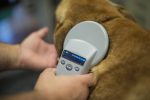Yes you do! You’d like to think pet microchip maintenance is as easy as 1-2-3! Microchips do improve the chance your pet, if he or she gets lost, is returned home to you. Yet, it isn’t always that simple. Microchips themselves don’t require maintenance, but there are three basic steps you need to do to ensure better odds of a happy reunion.
- Register the chip. Register the microchip in your name along with your contact information in the microchip manufacturer’s registry. Failure to register the microchip is the Achilles heel to the efficacy of the microchip’s premise of successfully reuniting lost pets with their owners. “Sixty percent of the microchipped pets out there are not registered to individual owners,” said Luis Aguilar, customer service / sales manager at Avid Identification Systems, Inc. “Many owners assume if their pet came from a breeder, shelter or rescue organization that the chip is automatically registered–it’s not! We maintain records on file about who bought the microchip and where it was shipped but until the consumer–pet owner–registers the microchip we don’t know who the pet owner is. The product is the product, it gets implanted on the pet, but who owns the pet? We don’t know.”
-

Veterinarian checking the location of a dog’s microchip
Check the chip. Ask your veterinarian to scan your pet’s microchip as part of the routine exam to make sure the microchip is readable and in the right location. Sometimes microchips migrate from the spot between the shoulder blades to different locations in the body. This means it could be overlooked by someone running a scan. If the chip has migrated, your vet can advise you about the next steps to take.
- Update your contact information. Once you’ve registered the microchip, the second most important point is to make sure your contact information is correct and current. “If you move, change telephone numbers, rehome your pet to another owner or adopt a pet from another owner, you need to update your information in the registry. Otherwise, recovering your lost pet is extremely difficult at best or, sadly, impossible according to a spokesperson with Home Again, the Merck Animal Health pet recovery service.
Buyer Beware
- Microchip codes. A microchip is a small, glass encased electronic device the size of a grain of rice implanted under the skin in between the shoulder blades of your dog or cat. It isn’t a tracking device, nor does it contain a battery. Microchips use Radio Frequency Identification technology (RFID) that activates when a scanner passes over it. Once activated by the scanner the microchip’s identification number appears on the scanner’s screen.
Each microchip has a unique number–either nine, 10 or 15 digits and the first three digits identify the microchip manufacturer. Usually microchip manufacturers that have a long history of reliable, reputable business have a unique three-digit code that is easily recognizable. Avid’s unique three-digit prefix is 977 and 985 is HomeAgain’s prefix.
The problem is, the influx of shared codes coming in from overseas. They all share one number: 900. There are more than 90 companies that share the 900 number and no way to know who owns that number, how to track the microchip or know if the microchip is registered. It’s chaos for shelters that find a pet with a 900-microchip and devastation for the pet owner.
Aguilar’s advice to pet owners is ask your vet or shelter which product they use before the microchip is implanted. If they use a 900 product, ask for a known chip manufacturer. If your pet already has a 900 chip, register with at least three of the known microchip registries because they are they first ones to get recovery calls plus they cross-reference with other manufacturers’ registries.
- Microchip registries. There are numerous registries and they vary in cost and services. Some registries have a one-time fee per pet owner or an annual fee. Other registries are free. The word of caution here is that some of the free registries dump owner information into a database and provide no service while others may sell the database to vendors. To counteract these practices, carefully read the registry’s published Privacy Policy. A reputable registry has a customer service telephone number with a representative available 24-hours a day to assist with pet recovery with shelters and owners.
The American Animal Hospital Association (AAHA) created the AAHA Universal Pet Microchip Lookup Tool to help with registry identification. The tool is not a registry but a database of registries of participating companies. However, not all microchip companies are participants yet. Visit the website, enter your pet’s microchip number, and check that your information is correct. If your pet’s microchip company is not a participant, you’ll get a message that identifies the manufacturer and its telephone for you to call.
That’s just one reason you should always register with the microchip manufacturer. AAHA Universal Pet Microchip Lookup Tool is at www.petmicrochiplookup.org.
Microchips are a simple, safe, permanent way to identify your pet and increase the probability of successful recovery should your pet become lost. Pet microchip maintenance is as easy as:
- Register the chip
- Check the chip and
- Keep your contact information updated.
Is your pet microchipped? If so, when is the last time you checked to make certain your information is up to date?
Article By Ramona Marek
This post was originally posted for Check the Chip Day. Reposted August 19, 2018.

